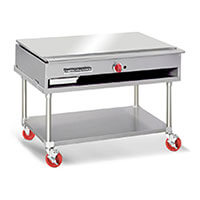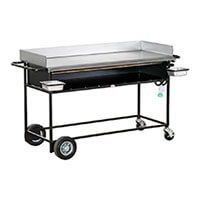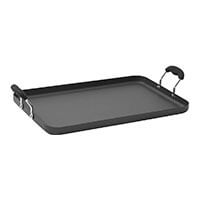Commercial Griddle Guide

Table of Contents
Essential flat-top cooking equipment for restaurants and commercial kitchens
Commercial griddles are versatile flat-top cooking surfaces designed for high-volume foodservice operations, providing efficient searing, frying, and cooking capabilities in restaurants, diners, and commercial kitchens. These heavy-duty appliances feature large, flat cooking surfaces that deliver consistent heat for preparing breakfast items, burgers, sandwiches, and various menu offerings. From countertop electric models to gas-powered units, choosing the right griddle depends on your menu requirements, kitchen space, power availability, and cooking volume. Essential for establishments serving breakfast, burgers, or diverse menus, griddles offer versatility that traditional ranges cannot match.
Key Applications in Commercial Kitchens
- Breakfast cooking (pancakes, eggs, bacon, sausage)
- Burger and sandwich preparation
- Sautéing vegetables and proteins
- Quesadilla and flatbread cooking
- High-volume food production for buffets and cafeterias
- Commercial flat-top cooking for diverse menu items
Types of Commercial Griddles
Commercial griddles are categorized by installation type and power source, offering different solutions for various kitchen layouts and operational needs. Each type serves specific restaurant requirements from traditional ranges to specialized cooking stations.
Electric Ranges with Griddles
Full-size electric ranges that incorporate built-in griddle sections, combining range cooking with flat-top griddle capabilities.

- Best Uses: Full-service restaurants, hotels, institutions requiring both range and griddle functionality
- Capacity: 24"-48" griddle sections; 14,000-35,000 watts total power
- Features: Integrated controls, thermostatic griddle temperature control, multiple burners plus griddle
- Pros: All-in-one cooking solution, consistent heat across cooking surfaces, space efficient
- Cons: Higher cost, larger footprint, requires dedicated electrical service
Gas Ranges with Griddles
Full-size gas ranges with integrated griddle surfaces, providing traditional gas cooking combined with flat-top griddle performance.

- Best Uses: Traditional restaurants, diners, operations preferring gas cooking with griddle capabilities
- Capacity: 24"-48" griddle sections; 20,000-60,000 BTU total
- Features: Gas burner controls, thermostatic or manual griddle heat control, stainless steel construction
- Pros: Fast heat recovery, responsive temperature control, familiar gas cooking
- Cons: Requires gas line installation, ventilation considerations, higher operating costs
Countertop Gas Griddles
Standalone gas-powered griddles designed for countertop installation, offering flexibility in kitchen placement.

- Best Uses: Restaurants with limited space, quick-service operations, breakfast-focused menus
- Capacity: 12"-72" widths; 15,000-60,000 BTU per burner
- Features: Individual burner controls, adjustable heat settings, removable grease gutters
- Pros: Powerful heating, responsive control, versatile placement
- Cons: Requires gas service, ventilation needed, higher maintenance than electric
Countertop Electric Griddles
Self-contained electric griddles for countertop use, providing flameless operation with consistent heating.

- Best Uses: Restaurants without gas service, cafes, operations requiring precise temperature control
- Capacity: 12"-72" widths; 1.5-6 kW power output
- Features: Thermostatic controls, even heat distribution, easy cleanup, low maintenance
- Pros: Precise temperature control, no open flame, energy efficient, quiet operation
- Cons: Slower heat recovery than gas, requires dedicated electrical circuits
Teppanyaki & Drop-In Griddles
Specialized griddles designed for teppanyaki-style cooking or built-in installations, featuring large cooking surfaces for performance cooking.

- Best Uses: Japanese restaurants, entertainment dining, custom kitchen installations
- Capacity: 24"-72" cooking surfaces; electric or gas powered
- Features: Large flat surfaces, built-in hoods, specialized cooking tools, high heat output
- Pros: Dramatic cooking presentation, large capacity, specialized applications
- Cons: Higher cost, requires skilled operators, specialized maintenance
Commercial Outdoor BBQ Griddles
Heavy-duty griddles designed for outdoor commercial use, built to withstand weather and high-volume outdoor cooking.

- Best Uses: Outdoor venues, sports stadiums, event catering, mobile food operations
- Capacity: 24"-48" cooking surfaces; gas-powered with high BTU output
- Features: Weather-resistant construction, heavy-duty burners, grease management systems
- Pros: Outdoor durability, high heat output, weather-resistant design
- Cons: Gas-only operation, ventilation requirements, higher maintenance
Induction Griddles
Modern griddles using electromagnetic induction for precise, energy-efficient heating of compatible cookware.

- Best Uses: Modern restaurants, energy-conscious operations, facilities requiring precise temperature control
- Capacity: 12"-48" cooking zones; 1.5-3.5 kW per zone
- Features: Instant heat-up, precise temperature control, cool surface, energy efficient
- Pros: Fast response, energy savings, enhanced safety, precise control
- Cons: Requires induction-compatible cookware, higher upfront cost
Commercial Stove Top Griddles
Cast iron or steel griddle pans designed for use on existing stove tops, providing affordable flat-top cooking options.

- Best Uses: Small operations, backup cooking, limited budget operations
- Capacity: 10"-24" diameters; manual stovetop heating
- Features: Durable construction, even heat distribution, affordable pricing
- Pros: Low cost, versatile use, easy storage, no special installation
- Cons: Manual temperature control, limited size, requires compatible cooktop
Griddle Control Types
Griddles offer different control mechanisms depending on power source, affecting temperature precision and operational efficiency.
Gas Griddle Controls
Gas griddles feature several control options for heat management:
- Digital Controls: Electronic temperature displays with precise adjustments, allowing exact temperature settings and programmable features
- Thermostatic Controls: Mechanical temperature sensors that cycle burners on/off to maintain consistent surface temperatures
- Manual/Snap Action: Simple on/off controls with adjustable gas valves, requiring operator skill for temperature management
- Solid State Controls: Infinite heat control with LED indicators, providing variable heat settings without thermostats
Electric Griddle Controls
Electric griddles primarily use electronic control systems:
- Thermostatic Controls: Digital or mechanical temperature controls that cycle heating elements to maintain precise temperatures
- Solid State Controls: Infinite heat adjustment with visual indicators, offering variable power levels
- Programmable Controls: Advanced systems with timers, temperature probes, and programmable cooking cycles
Griddle Type Comparison
| Type: | Power Source: | Best For: | Size Range: | Installation: |
| Electric Ranges with Griddles | Electric | Full-service restaurants | 24"-48" | Floor-standing range |
| Gas Ranges with Griddles | Gas | Traditional kitchens | 24"-48" | Floor-standing range |
| Countertop Gas Griddles | Gas | High-volume operations | 12"-72" | Countertop |
| Countertop Electric Griddles | Electric | Precise cooking needs | 12"-72" | Countertop |
| Teppanyaki & Drop-In Griddles | Electric/Gas | Specialty dining | 24"-72" | Drop-in/built-in |
| Commercial Outdoor BBQ Griddles | Gas | Outdoor venues | 24"-48" | Outdoor installation |
| Induction Griddles | Electric | Modern kitchens | 12"-48" | Countertop |
| Commercial Stove Top Griddles | Manual | Small operations | 10"-24" | Stovetop |
Note: Capacities and features vary by model; always check manufacturer specifications and local codes.
Griddle Surface Materials
The cooking surface material significantly impacts performance, durability, and cooking results.
Steel Plate Griddles
Steel plates offer durability and even heat distribution for heavy-duty commercial applications.
- Thickness: 1/2"-3/4" thick polished steel
- Best For: High-volume operations, heavy-duty cooking
- Pros: Excellent heat retention, durable surface, even cooking
- Cons: Requires proper seasoning, can warp if not maintained
Chrome Plate Griddles
Chrome-plated surfaces provide a non-stick cooking experience with easy cleanup.
- Thickness: 1/4"-1/2" chrome over steel base
- Best For: Quick-service operations, easy maintenance requirements
- Pros: Non-stick surface, easy cleaning, reduced oil usage
- Cons: Can scratch over time, requires gentle cleaning
Grooved vs. Smooth Surfaces
Surface texture affects cooking performance and food presentation.
- Smooth Surfaces: Traditional flat cooking for even searing and versatile cooking
- Grooved Surfaces: Creates grill marks and allows grease drainage for specific menu items
Selecting Commercial Griddles
Choosing the right griddle requires careful consideration of operational needs, space constraints, and menu requirements.
Cooking Surface Size & Capacity
Match griddle size to your production volume and menu complexity.
- 18"-24" Griddles: Small operations, cafes, limited menu items
- 24"-36" Griddles: Medium restaurants, family-style operations
- 36"-48" Griddles: Large restaurants, high-volume operations
- 48"+ Griddles: Banquet facilities, institutional kitchens
Power Source Considerations
Select based on available utilities and operational preferences.
- Gas Griddles: Choose when gas service is available and high heat output is needed
- Electric Griddles: Ideal for facilities without gas or requiring precise temperature control
- Induction Griddles: Best for modern operations prioritizing energy efficiency
Temperature Control & Features
Consider control mechanisms that match your cooking style.
- Thermostatic Controls: Essential for consistent results and menu standardization
- Manual Controls: Suitable for experienced operators who prefer hands-on temperature management
- Additional Features: Grease gutters, splash guards, removable elements
Installation & Space Requirements
Evaluate physical constraints and workflow integration.
- Countertop Models: Require 24"-36" counter space and proper ventilation
- Drop-In Models: Need countertop modification and professional installation
- Clearance Requirements: Allow 6" clearance from combustible surfaces
Budget & Operating Costs
Factor in total cost of ownership including installation and maintenance.
- Entry-Level: $500-1,500 (basic countertop electric models)
- Mid-Range: $1,500-3,000 (commercial-grade gas models)
- Premium: $3,000+ (large induction or custom drop-in models)
- Operating Costs: Gas models cost more to operate; electric models offer better efficiency
Safety & Compliance
Prioritize equipment meeting health and safety standards.
- NSF Certification: Required for commercial foodservice equipment
- UL Listing: Electrical safety certification for electric models
- CSA Certification: Gas appliance safety standards
- Local Codes: Verify compliance with building and fire codes
Quick Selection Checklist:
- Daily cooking volume and menu complexity?
- Available power sources (gas/electric)?
- Counter space and installation requirements?
- Budget and operating cost considerations?
- Temperature control preferences?
Operation & Usage Guide
Proper operation ensures optimal performance and food safety in commercial griddle cooking.
Setup & Preheating
Prepare the griddle for efficient cooking operations.
- Position Correctly: Ensure proper clearance and ventilation around the griddle
- Check Connections: Verify gas lines or electrical connections are secure
- Preheat Properly: Allow 10-15 minutes for griddle to reach operating temperature (350-400°F)
- Season Surface: Apply thin layer of oil to protect steel surfaces
- Test Temperature: Use infrared thermometer to verify even heat distribution
Cooking Techniques
Master different cooking methods for optimal results.
- Searing: High heat (400-450°F) for proteins, quick contact for Maillard reaction
- Frying: Medium heat (350-375°F) for eggs, pancakes, and delicate items
- Holding: Low heat (250-300°F) for keeping items warm during service
- Sweating: Medium-low heat (300-325°F) for vegetables and aromatics
Temperature Guidelines
Different foods require specific temperature ranges for best results.
| Food Item: | Temperature Range: | Cooking Time: | Technique: |
| Eggs | 325-350°F | 2-4 minutes | Gentle heat for even cooking |
| Pancakes | 350-375°F | 2-3 minutes per side | Medium heat for golden color |
| Bacon | 350-400°F | 3-5 minutes | Medium-high for crispiness |
| Burgers | 400-450°F | 4-6 minutes | High heat for searing |
| Vegetables | 350-375°F | 3-5 minutes | Medium heat for texture |
| Grilled Cheese | 325-350°F | 3-4 minutes | Medium heat for melting |
Cookware Selection
Choose appropriate tools for safe and efficient griddle cooking.
- Spatulas: Use metal or high-heat plastic spatulas designed for griddles
- Scrapers: Stainless steel scrapers for cleaning and portioning
- Tongs: Long-handled tongs for safe food handling
- Ladles: Heat-resistant ladles for batters and sauces
- Release Sheets: PTFE-coated nonstick sheets that provide a disposable cooking surface, preventing food from sticking and making cleanup easier. Ideal for delicate items or when seasoning isn't desired.
Maintenance & Cleaning
Regular maintenance ensures griddle longevity and food safety. Following proper cleaning procedures prevents grease buildup and maintains cooking performance.
Daily Cleaning Procedures
- Turn Off and Cool Down: Allow griddle to cool to a safe temperature (below 150°F) before cleaning
- Scrape Off Large Debris: Use a stainless steel scraper to remove food residue and excess grease. Work in sections from front to back, pushing debris toward the grease gutter
- Apply Cleaning Solution: For steel griddles, turn heat on medium and add water mixed with commercial degreaser. For chrome griddles, use gentle cleaners to avoid scratching
- Scrub Surface: Use a griddle brick or pad to loosen baked-on residue. Work in circular motions for even cleaning
- Rinse Thoroughly: Wipe away cleaning solution with clean water or steam clean if available
- Dry Completely: Ensure surface is thoroughly dry to prevent rust and maintain seasoning
- Season Surface: Apply thin layer of high-smoke-point oil to steel surfaces for protection
Cleaning the Grease Gutter & Catch Tray
- Remove Components: Carefully remove grease gutter and catch tray from griddle
- Dispose of Grease: Empty grease into approved containers following local disposal regulations
- Wash Components: Clean gutter and tray with hot, soapy water using a scrub brush
- Sanitize: Apply food-safe sanitizer and rinse thoroughly
- Dry and Reinstall: Ensure components are completely dry before reinstalling
Weekly Maintenance Tasks
- Deep clean burners and gas ports (gas models)
- Inspect heating elements for damage (electric models)
- Check thermostat calibration and adjust if needed
- Lubricate moving parts and hinges
- Inspect electrical connections and gas lines for safety
Monthly Maintenance Tasks
- Professional cleaning service for thorough deep cleaning
- Calibration of temperature controls
- Inspection of ventilation systems and exhaust hoods
- Replacement of worn scraper blades and cleaning tools
- Documentation of maintenance activities for compliance
Safety Precautions
- Always wear heat-resistant gloves and appropriate kitchen attire
- Use proper lifting techniques when handling hot griddle components
- Keep fire extinguishers accessible and staff trained in their use
- Ensure proper ventilation to prevent grease-laden vapor accumulation
- Never leave cleaning chemicals unattended on hot surfaces
Common Issues & Troubleshooting
- Uneven Heating: Check for proper seasoning, clean burners, or calibrate thermostat
- Sticking Food: Re-season surface or increase oil usage for steel griddles
- Excessive Smoke: Clean more frequently or reduce heat settings
- Warped Surface: Consult manufacturer for resurfacing options
- Thermostat Inaccuracy: Have unit professionally calibrated
Cleaning Frequency Guidelines
- After Each Use: Scrape and wipe down surface, empty grease gutter
- Daily: Full cleaning procedure for high-volume operations
- Weekly: Deep cleaning for moderate-volume operations
- Monthly: Professional maintenance for all commercial units
Frequently Asked Questions
What's the difference between a griddle and a griddle plate?
A griddle is a complete cooking appliance with heating elements, controls, and grease management. A griddle plate is just the cooking surface that can be added to existing ranges or cooktops.
How often should I season my steel griddle?
Season steel griddles after each cleaning by applying a thin layer of high-smoke-point oil and heating until it polymerizes. Re-seasoning may be needed weekly for new griddles, then monthly for established ones.
Can I use any oil on my griddle?
Use oils with high smoke points like canola, peanut, or grapeseed oil. Avoid olive oil or butter which can smoke and burn at griddle temperatures.
What's the best griddle size for my restaurant?
Calculate based on peak demand: 12"-18" per cook station, with 24"-36" being most common for restaurants. Consider menu complexity and service style.
How do I prevent food from sticking to my griddle?
Ensure proper seasoning on steel surfaces, use appropriate oils, maintain correct temperatures, and clean regularly to prevent residue buildup.
Are gas griddles more efficient than electric?
Gas griddles heat faster and offer more responsive temperature control, making them more efficient for high-volume operations. Electric griddles provide more consistent heat for steady cooking.
How long does it take for a griddle to heat up?
Gas griddles typically reach cooking temperature in 10-15 minutes. Electric griddles may take 15-25 minutes depending on size and power.
Can I cook different foods on the same griddle surface?
Yes, but practice good hygiene by cooking similar items together and thoroughly cleaning between different food types to prevent cross-contamination.
What's the warranty on commercial griddles?
Most commercial griddles come with 1-3 year warranties covering parts and labor. Extended warranties are often available for additional protection.
How do I know if my griddle needs resurfacing?
Signs include visible warping, deep scratches that affect cooking, or uneven heat distribution that cleaning doesn't resolve. Consult a professional for resurfacing.
Related Equipment & Guides
Similar Equipment
- Commercial Salamander Guide - Overhead broiling equipment for finishing and browning
- Commercial Cheese Melter Guide - Specialized equipment for cheese melting and finishing
- Commercial Cookware Guide - Compatible cookware for griddle cooking
- Commercial Ranges - Complete cooking ranges with integrated griddle options
- Commercial Ventilation - Essential exhaust systems for griddle operation
- Grill & Griddle Accessories - Scrapers, brushes, and maintenance tools
- Grill & Griddle Release Sheets - Nonstick cooking sheets for easier food release and cleanup
- Clamshell Griddle Hoods - Pressing attachments that convert griddles into clamshell cookers
- Induction Griddles - Energy-efficient induction griddle options
- Commercial Cleaning Supplies - Degreasers and cleaning chemicals for griddles
Browse our selection of professional griddles designed for commercial kitchen flat-top cooking:
Countertop Gas Griddles - High-efficiency gas griddles for restaurants
Countertop Electric Griddles - Precise electric griddles for consistent cooking
Grill & Griddle Accessories - Essential tools for griddle maintenance and operation
Need help selecting the right commercial griddle for your operation? Contact our foodservice specialists for personalized recommendations based on your menu volume, space constraints, and power requirements.
Share This!